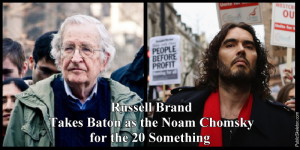
Noam Chomsky (left) photo by Andrew Rusk. Russell Brand photo by Dan Kitwood (CC BY 2.0)
Fortunately there is a website which has harvested many of Chomsky’s work at http://www.chomsky.info/.
After reviewing Chomsky’s considerable material one begins to understand how Russell Brand has arguably taken on many of the roles that Chomsky has been doing for most of his life.
Chomsky, now in his golden years, emanates these days as a ship weathered by many years at sea. However, still seaworthy, the port is near.
Chomsky’s vigor, energy, and lust for “factualization” of the events in the world around us, helped us understand that there are narratives out there being hurled out at us like fire balls at a castle.
With 8,818,326 followers, and 868,967 (updated Dec. 26, 2014 13:29 EST) subscribers on his Twitter Page and YouTube Channel respectively, it is clear that segments in today’s society have tipped their hat to Brand.
As evidenced in his book “Revolution” chapter 30 “Manifest Destiny” Brand makes it clear he will continue that which has already been started by Chomsky.
On the issue of society, power and government, Brand quotes Chomsky, “For this reason alone, it is imperative to sweep away the ideological clouds and face honestly and realistically the question of how policy decisions are made, and what we can do to alter them before it is too late.” In response, Brand writes, “I’ll take it from here.”
As Chomsky’s wave brings him into the shoreline, in the background we see, Russell Brand feverishly paddling on his Trews logo riddled surfboard trying to get in front of the mounting wake lurking beneath him.
In just this year Brand has managed to paddle his board in front of that wave. And then, he has accomplished to push himself up on his Trews surfboard.
He then has shuffled a bit, to the left and then to the right. Then he finally gained his composure to begin the ride in front of the wave unrelentingly crashing down around him. Much like the thundering skyscraper waves of the North Shore.
In his hand, can you see it? It’s the baton handed to him metaphorically by Chomsky. He takes it, with all the zest one could ever hope for. Brand then threads a strap through it and loops it first over his flaring wild hair then to have it settle around his neck. All the time being sprayed with a hundred mile an hour ocean mist.
Alas, he wipes the stinging salty water from his face, and with a piercing gaze not unlike that of a Great White shark locking in on its prey, Brand fixes in on the shore of societal unrest fast approaching.
We look forward to Brand’s eventual arrival after having ridden, perhaps many waves to finally reach the shore we stand. Gazing with curiosity, amazement and inspiration, we realize a sense of clarity of perspective.
The sun rises, then fades into a gently disappearing sunset.
A loud crash is heard, and the brightness of our view begins to reveal Brand now trotting through the shin deep water, holding only half of a surfboard and a severed bungee cord. The other half of the board is seen blowing violently across the white-wash receding back into the ocean, leaving a highly reflective sheen across the sand.
At that moment, we expect and receive the usual remarks from Brand recounting his journey of what was, and what can be, in his unique and Trewsish manner.
As the camera cranes upward opening the frame from Brand to a reveal of the crowds around him and ocean and shoreline in the distance, in the corner we notice his white fury companion, running to greet him.
After holding the shot with a distant sunset and glimmer over the waves below, the image fades to black.
The sound of an ocean surf then is heard as the credits begin to roll.
Oh, and by the way:
Russell Brand, will you please . . .
ANSWER THE QUESTION!!!

Noam Chomsky (left) photo by Andrew Rusk. Russell Brand photo by Dan Kitwood (CC BY 2.0)
